初中英语人教版七年级下册Unit 3 Section B Reading
人教版英语七年级下册Unit 3 Section B(2a-2d)新版课件
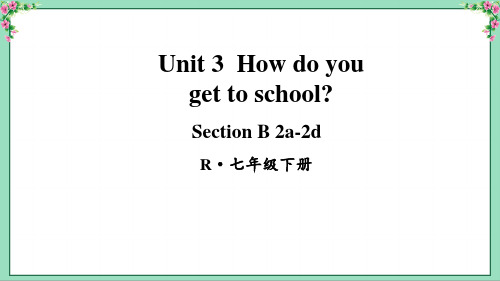
Tips: First understand the questions, then find the answers in the text.
Read Para. 2 & Para. 3 and fill in the blanks.
to understand the general idea of the passage.
Look at the layout(布局)of the story and answer.
➢Where can you see the story? A. In a newspaper. B. In a magazine. C. In a book.
Careful-reading
Read Para. 1 and judge the sentences “T” or “F”.
T 1. For many students, it’s not hard to get to school. F 2. For the students in one small village in China, it’s
Tips: Sometimes, we can judge the type of article by its layout.
Fast-reading
Read the news story from some years 2b ago and choose the best title for it.
Learn to guess the main idea of the passage and talk about how to get to places.
人教版初中英语七年级下册Unit 3 Section B名师课件(三课时)

Practice
A: How does he get to school? B: First, he ...
Then he ...
Practice
A: How does he get to school? B: First, he rides a bike to the subway station.
Their dream is to have a bridge. I think their dream can come true. Maybe the government can build a bridge for them.
1. For the students in the village, itdifsfic_u_lt_______ to get to school. It is (not)+ adj. + to do sth.
For example
A: How do you get to school? B: First, I ...
Then I …
Practice
A: How does he get to work? B: First, he walks to the bus stop.
Then he takes a bus to work.
Review How do you get to school? How long does it take?
18 minutes
I take a taxi to school. I get to school by taxi. It takes about 18 minutes.
人教版七年级英语下unit3SectionB
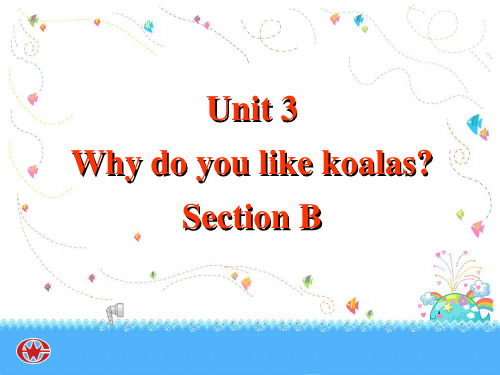
Section B
3a Read the description and match them with the animals.
Molly This is Molly. She is
twelve years old. She is from Africa. She likes to play with her friends and eat grass.
fruit. 改为eat或to climb → climbing 8. Penguins from the South Pole.
前面加are或come 9. —What do you like elephants? Why
—Because they are friendly. 10. We can see many animal in the zoo.
5. The music sounds r_e_l_a_x_in_g_ (relax).
Ⅲ. 根据短文及首字母提示, 补全单词。
This is Larry. He’s (1) f _r_o_m_ Africa. He’s six (2) y____ eoaldr.sHe is (3)l___ . Hazey usually (4)s_le_e_p_s20 hours every day. He likes (5)e_a_ti_n_g_ meat, and he likes to (6)p_la_y_ with his friends. He’s kind of popular in the (7)z_o_o_. Many people like this interesting (8)a_n_im__a_l_.
人教版英语七年级下册Unit3 SectionB 教材知识详解

Unit3 SectionB 教材知识详解1. Mary wants to know what he thinks of the trip.玛丽想知道他认为这段旅程怎么样。
(1)这是一个含有what引导的宾语从句的主从复合句,主句的主语是Mary,谓语是wants to know,宾语是一个特殊疑问句,原句应为“What does he think of the trip?”,但在宾语从句中,从句的语序要用陈述语序,其中疑问词仍在句首,位置不变;另外,宾语从句的时态与主句的时态要一致。
如:I know where you live.我知道你住在哪儿。
Thomas wants to know how she gets to school.托马斯想知道她怎样到学校。
(2) think of意为“认为;考虑”。
of为介词,其后可接名词、代词或动名词作宾语,在表示“认为……怎么样”时,可与think about互换。
如:—What do you think of/about the school trip?你认为这次学校郊游怎么样?一It’s great.非常好。
What do you think of...?意为“你认为……怎么样?”,可与How do you like...?进行转换,这是用来询问某人对某事或某人的看法的常用句型。
如:What do you think of action movies?=How do you like action movies?你认为动作片怎么样?2. Crossing the River to School过河去学校cross(1)动词,意为“越过;穿过”,主要指“横穿”。
如:The little boy can’t cross the street by himself.这个小男孩不能独自过马路。
(2)名词,意为“十字形,叉形记号”。
如:The teacher marked the question with a cross.老师在这个问题上打了一个叉。
2021人教版英语七年级下册unit3sectionB课件
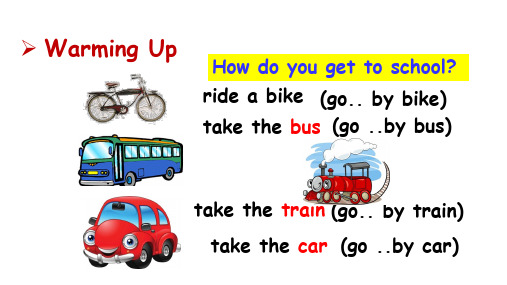
1a Match the words with the pictures.
1. __b_bus stop
3. _c__ bus station
2. _a__ train station 4. _d__ subway station
1b
Tell your partner how you get to school. Imagine you use two types of transportation.
A: How do you get to school? B: Well, I ride my bike to the subway
station. Then I take the subway.
Listen and check (√)the things that 1c Mary wants to know.
5. If they live around the river, they can go somewhere _______. A. by train B. by taxi C. by boat
➢ Warming up
river
boat
bridge
village
villagers
ropeway
between
There are many apples on the tree.
【拓展】 have侧重于主观方面,强调“所属” 关系, 表示“拥有,占有,具有”。在这一结构中, have与主语保持人称和数的一致。 如:
She has a nice schoolbag.
between … and … 在……与……之间 between 是个介词,表示在两者之间。 如:
true
人教PEP版英语七年级下册 Unit 3 Part B
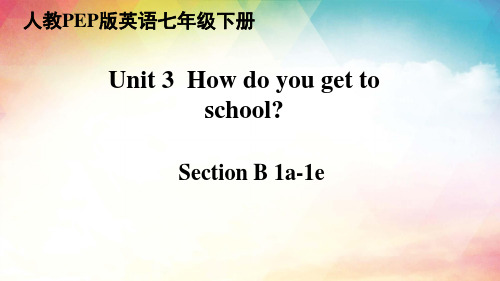
主语
谓语
宾语
think of意为“认为;想起”。 of为介词,其后可接名词、代词或动名词形式。
例: 你认为跳舞怎么样? What do you think of dancing?
句型:What do you think of… = How do you like… 你认为……怎么样? 用来询问某人对某事或某人的看法。
Pair work
Look at the picture to tell how Tom gets to his aunt’s home.
First he walks to the bus stop.He takes a bus to the train station.Then he takes the train.Next he takes a bus from the train station to his aunt’s home.
Mary wants to know…____ where Bob lives.____ how far he lives from his grandparents’ home.____ how he gets to his grandparents’ home.____ how long it takes to get to his grandparents’ home.____ what he thinks of the trip.
Sentences: — How do you get to school? — Well, I ride my bike to the subway station. Then I take the subway.
walk to the bus stop
人教版初中英语七年级下册Unit3SectionB教材全解

人教版初中英语七年级下册Unit3SectionB教材全解Unit 3 How do you get to school?Unit 3 Section B教材全解1.bus stop 公共汽车站【重点注释】stop,此处用作名词,意为“车站;站点”。
例如:at a/the bus stop在公共汽车站。
stop一般指的是小站,停车点,如路边的停车站点;station指的是总站,大型的车站,at a bus/train/subway station。
例如:They wait for Jim at the bus stop.他们在公共汽车站等吉姆。
Where si the bus station?公共汽车站在哪儿?Stop talking,please.请停止(正在)说话(这个事)。
They stop to smoke a cigarette.他们停下来(原来干的事),(然后)抽了根烟。
I must stop smoking.我必须戒烟了(我必须停止正在抽烟这个事)。
2.Mary wants to know where Bob lives.玛丽想知道鲍勃住在哪儿。
Mary wants to know what he thinks of the trip.玛丽想知道他(鲍勃)认为这段旅程怎么样。
【重点注释】①Mary wants to know where Bob lives.玛丽想知道鲍勃住在哪儿。
本句含有一个由连接词where引导的宾语从句。
在复合句中用作宾语的从句叫宾语从句。
无论主句是陈述句还是疑问句,宾语从句都必须使用陈述语序,即“主句+连词+宾语从句(主语+谓语+……)”句式。
如果主句的谓语动词是一般现在时,从句的谓语动词可根据需要,选用相应的任何时态。
例如:Please tell me who knows the answer.请告诉我谁知道答案。
Do you know which class he is in?你知道他在哪个班级吗?I don’t know when he will come back.我不知道他将何时回来。
人教版七年级下册unit3 阅读公开课课件
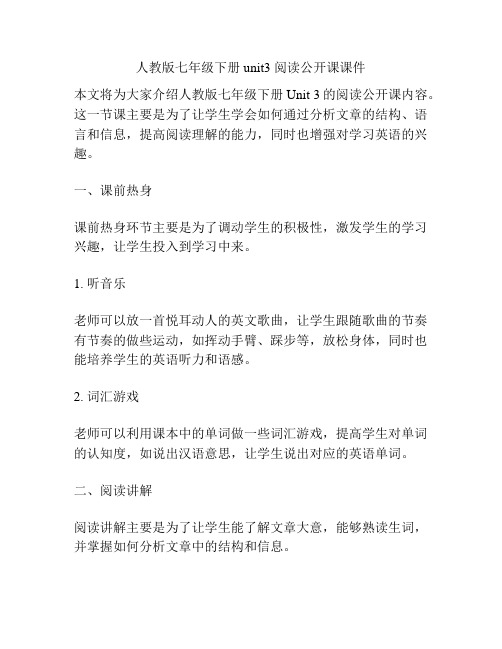
人教版七年级下册unit3 阅读公开课课件本文将为大家介绍人教版七年级下册Unit 3的阅读公开课内容。
这一节课主要是为了让学生学会如何通过分析文章的结构、语言和信息,提高阅读理解的能力,同时也增强对学习英语的兴趣。
一、课前热身课前热身环节主要是为了调动学生的积极性,激发学生的学习兴趣,让学生投入到学习中来。
1. 听音乐老师可以放一首悦耳动人的英文歌曲,让学生跟随歌曲的节奏有节奏的做些运动,如挥动手臂、踩步等,放松身体,同时也能培养学生的英语听力和语感。
2. 词汇游戏老师可以利用课本中的单词做一些词汇游戏,提高学生对单词的认知度,如说出汉语意思,让学生说出对应的英语单词。
二、阅读讲解阅读讲解主要是为了让学生能了解文章大意,能够熟读生词,并掌握如何分析文章中的结构和信息。
1. 课文内部结构分析让学生了解课文的结构,比如文章的开头、中间和结尾部分,以及各个部分的主要内容是什么,让学生理解文章的大意。
2. 课文语言分析通过教学素材中的句子提取关键词汇,然后通过讲解让学生了解它们的意思以及如何使用。
3. 阅读策略教学老师可以向学生介绍一些常见的阅读策略,如预测、猜测意思、划重点等,让学生在阅读时能够抓住文章的重点和难点,提高解读效率和准确度。
三、阅读练习阅读练习是为了让学生通过练习巩固所学的知识,提高阅读能力。
1. 翻译练习老师可以在黑板上写出一些英文句子,让学生逐句进行翻译,以检测学生对所学词汇和句子的掌握情况。
2. 阅读理解练习老师可以为学生布置一篇短文或阅读理解题目,让学生通过阅读、理解和归纳提高自己的阅读能力,并培养学生的思维能力。
四、课堂总结老师可以在课堂结束时,对上述内容进行总结和回顾,让学生理解自己的不足,为下一节课的学习做好准备。
在这样一个丰富多彩的课堂环节中,学生能够快乐地学习英语,培养不同的技能,例如听说读写等,同时也能给学生提供一个全面了解英语文化和深入了解英文阅读的机会。
Go for it七下 Unit 3 Section B 2a教案
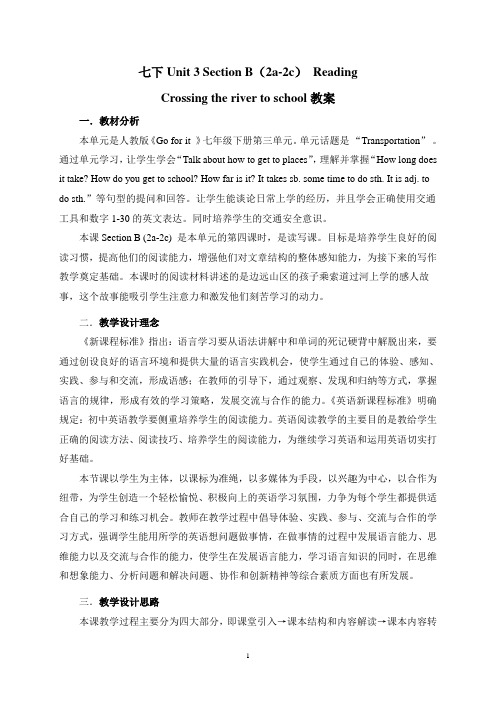
七下Unit 3 Section B(2a-2c)ReadingCrossing the river to school教案一.教材分析本单元是人教版《Go for it 》七年级下册第三单元。
单元话题是“Transportation”。
通过单元学习,让学生学会“Talk about how to get to places”,理解并掌握“How long does it take? How do you get to school? How far is it? It takes sb. some time to do sth. It is adj. to do sth.”等句型的提问和回答。
让学生能谈论日常上学的经历,并且学会正确使用交通工具和数字1-30的英文表达。
同时培养学生的交通安全意识。
本课Section B (2a-2c) 是本单元的第四课时,是读写课。
目标是培养学生良好的阅读习惯,提高他们的阅读能力,增强他们对文章结构的整体感知能力,为接下来的写作教学奠定基础。
本课时的阅读材料讲述的是边远山区的孩子乘索道过河上学的感人故事,这个故事能吸引学生注意力和激发他们刻苦学习的动力。
二.教学设计理念《新课程标准》指出:语言学习要从语法讲解中和单词的死记硬背中解脱出来,要通过创设良好的语言环境和提供大量的语言实践机会,使学生通过自己的体验、感知、实践、参与和交流,形成语感;在教师的引导下,通过观察、发现和归纳等方式,掌握语言的规律,形成有效的学习策略,发展交流与合作的能力。
《英语新课程标准》明确规定:初中英语教学要侧重培养学生的阅读能力。
英语阅读教学的主要目的是教给学生正确的阅读方法、阅读技巧、培养学生的阅读能力,为继续学习英语和运用英语切实打好基础。
本节课以学生为主体,以课标为准绳,以多媒体为手段,以兴趣为中心,以合作为纽带,为学生创造一个轻松愉悦、积极向上的英语学习氛围,力争为每个学生都提供适合自己的学习和练习机会。
Unit 3 Section B(1a-1d)七年级英语下册(人教版)
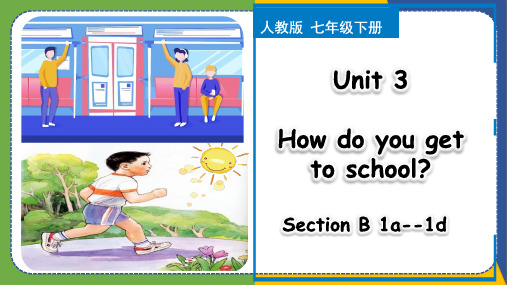
2. 宾语从句
Language points 语言点
充当宾语成分的句子叫宾语从句,常置于动词、介词、形容词后作 宾语成分,并由连接副词(when,where,wht,how……)连接。 宾语从句要用陈述语序。
Mary wants to know where Bob lives.
Bob: Yes, it is. So I go there and see my grandparents only one or two times a year.
Mary: How do you get there?
一年两次
Bob: I usually take the train.
Mary: How long does it take?
Mary wants to know how far he lives from his grandparents’ home.
Mary wants to know how he gets to his grandparents’ home.
Mary wants to know how long it takes to get to his grandparent’s home.
Then I take the subway.
1b Tell your partner how you get to school. Imagine you use
two types of transportation.
TAXI
A: How do you get to school? B: First, I …
How far is it (from your home to school)?
人教版七年级下册英语Unit3 Period 3 Section B(1a-2d)
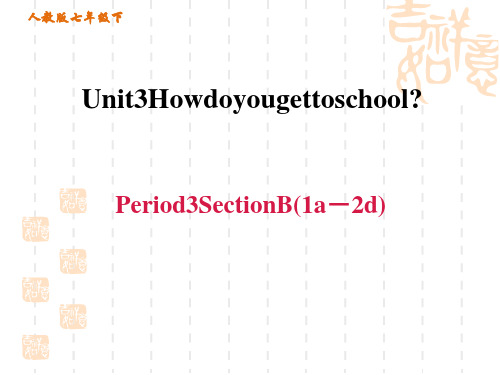
5 dream
10 cometrue
题组专训
1A Itisveryimportantforus
2 tolearnEnglishwell.
6 across 7B
3D
8C
答案呈现
11 D
4C
9 going
5A
10 C
1 years 2 villagers 3 between 4 bridge 5 leaves
2. 对于我们来说, 学好英语非常重要。 ____It_i_sv_e_r_y_i_m_p__o_rt_a_n_t_f_o_ru__st_o_l_ea_r_n_E__n_g_li_s_h_w_e_l_l.____
3. Itisdifficultforus______D__Englishwell. Butwecanaskourteacherforhelp.
cross
4. Allpeopleare___a_f_r_a_id_(害怕) offailure.
5. SometimesIhaveastrange________(梦) dream
inwhichItrytospeakbutIcan't.
二、根据汉语意思完成句子, 并背记英语句子 6. 他认为这次旅行怎么样?
人教版七年级下
Unit3Howdoyougettoschool?
Period3SectionB(1a-2d)
先练后背
提示:点击 进入习题
1 boat
6 What; thinkof
答案呈现
2 river 3 cross
7 For; toget 8 between; and
4 afraid
9 islike; to
人教版英语 七年级下册 Unit3 SectionB reading 课件
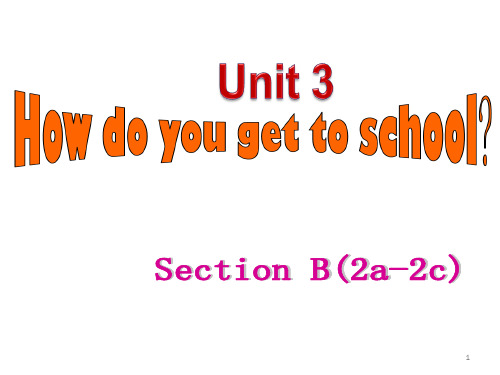
bridge
4
Task1.
Skimming
paragraphs.
Para1. Para2. Para3.
A. liangliang crosses the river every school day but he is not afraid.
B. it is difficult for the students in the village to get to school.
C. many of the students and villagers have a dream.
5
读文章,回答问题
6
Task1.
Match the main ideas with the paragraphs.
Para1. Para2. Para3.
A. liangliang crosses the river every school day but he is not afraid.
B. it is difficult for the students in the village to get to school.
Para1. Para2. Para3.
A. liangliang crosses the river every school day but he is not afraid.
B. it is difficult for the students in the village to get to school.
Look at the picture and title below.
Guess what the passage is about.
×
cross the river
2020-2021学年人教版英语七年级下册Unit3 SectionB reading 课件
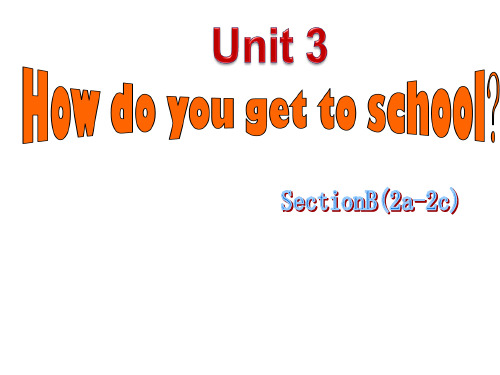
3.They cannot go by boat because the river runs too _q_u_i_c_k_ly_.
4.It is not easy to cross the river on a ropeway, but the boy is not _a_f_r_a_id_.
MLikiaenisgl_i_a_nD_g__is__abnoy1.1-Hyeeaisr-voelrdy bkionyd. to others.
• Liaan8-gyleiaarn-goldis 11 yearBs.oalnd.8-years-old CH. ais8f-ryieeanrd-olids a ten-yeDar.-aonld8-byoeayr.- old. His friend is ten years old.
A. What do the students like?
√B. How do the students go to school?
C. Where do the students live?
Fast-reading(快读)
2b Read it quickly in silence and answer the
Discuss (小组讨论): Do you think their dream can come true? I hope their dream can come true.
What can they do for themselves? What can we do for them?
+Unit+3Section+B+Reading+课件--2023-2024学年人教版英语七年级下册
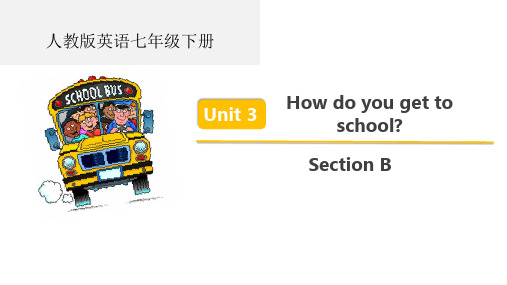
Dear editor, My name’s Liangliang. I’m an 11-year-old boy. I live in a small village in China. There is a big river 1. _b_e_t_w_e_e_n_ our school 2. ___an_d____ the village. There is no bridge and the river runs too quickly for boats. So we 3. _g_o__o_n_ _a__r_o_p_e_w_a_y__ to cross the river to school. I cross the river every school day, but I’m not 4. __af_r_a_id__. Because I love to play with my classmates. And I love my teacher. It is our dream to have a 5. _b_r_id_g_e_. Can our dream come true? Can you help us?
2. Why do they go to school like this? There is a very big river between their school and the village. There is no bridge and the river runs too quickly for boats.
I choose to go to National Library by bike, because it is good for healthy and it is also good for environment.
Unit 3SectionB2a-2d教案2021-2022学年人教版英语七年级下册
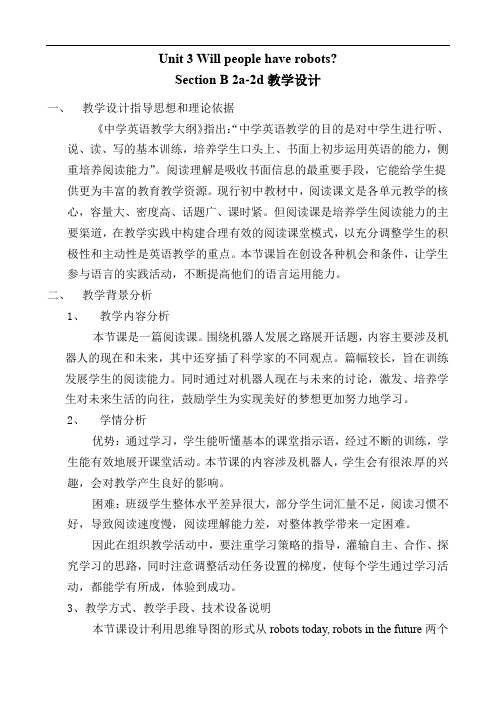
Unit 3 Will people have robots?Section B 2a-2d教学设计一、教学设计指导思想和理论依据《中学英语教学大纲》指出:“中学英语教学的目的是对中学生进行听、说、读、写的基本训练,培养学生口头上、书面上初步运用英语的能力,侧重培养阅读能力”。
阅读理解是吸收书面信息的最重要手段,它能给学生提供更为丰富的教育教学资源。
现行初中教材中,阅读课文是各单元教学的核心,容量大、密度高、话题广、课时紧。
但阅读课是培养学生阅读能力的主要渠道,在教学实践中构建合理有效的阅读课堂模式,以充分调整学生的积极性和主动性是英语教学的重点。
本节课旨在创设各种机会和条件,让学生参与语言的实践活动,不断提高他们的语言运用能力。
二、教学背景分析1、教学内容分析本节课是一篇阅读课。
围绕机器人发展之路展开话题,内容主要涉及机器人的现在和未来,其中还穿插了科学家的不同观点。
篇幅较长,旨在训练发展学生的阅读能力。
同时通过对机器人现在与未来的讨论,激发、培养学生对未来生活的向往,鼓励学生为实现美好的梦想更加努力地学习。
2、学情分析优势:通过学习,学生能听懂基本的课堂指示语,经过不断的训练,学生能有效地展开课堂活动。
本节课的内容涉及机器人,学生会有很浓厚的兴趣,会对教学产生良好的影响。
困难:班级学生整体水平差异很大,部分学生词汇量不足,阅读习惯不好,导致阅读速度慢,阅读理解能力差,对整体教学带来一定困难。
因此在组织教学活动中,要注重学习策略的指导,灌输自主、合作、探究学习的思路,同时注意调整活动任务设置的梯度,使每个学生通过学习活动,都能学有所成,体验到成功。
3、教学方式、教学手段、技术设备说明本节课设计利用思维导图的形式从robots today, robots in the future两个方面梳理文章脉络,并指导学生用思维导图来复述文章,锻炼学生的归纳总结和语言表达能力。
运用“讨论-限时自读-导读-复读-讨论”的基本课堂教学模式,设计学生学习活动。
人教版英语七年级下册 Unit3 SectionB reading 课件
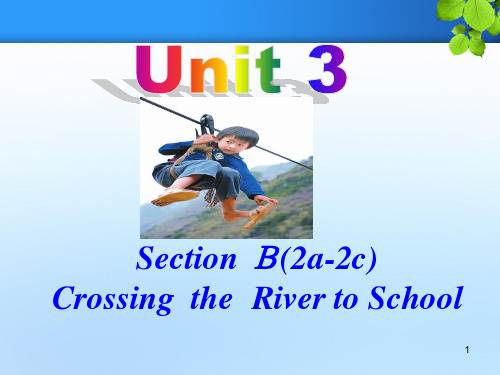
12
While-reading Read Paragraph 2 and answer the question.
How much do you know about Liangliang? 1H1oyweaorsldo?ld
8
Let’s enjoy a video
9
Q:Is the boy afraid (adj.害怕;畏惧) of taking a ropeway?
No, he isn’t.
10
Skimming What is the passage about?
It’s about how the students c ross a river to get to school.
11
Read Paragraph 1 and do T / F.
1.For many students, it is difficult to get to school. F
2. They have to cross a very big river between their school and the village. T
2
For us live in the city, it’s easy to go somewhere, we can…
1
2
3
5
63
But for the villager (n.村民)in the village (n.村庄;村镇) , it’s not easy to go somewhere.
What’s the passage about?
- 1、下载文档前请自行甄别文档内容的完整性,平台不提供额外的编辑、内容补充、找答案等附加服务。
- 2、"仅部分预览"的文档,不可在线预览部分如存在完整性等问题,可反馈申请退款(可完整预览的文档不适用该条件!)。
- 3、如文档侵犯您的权益,请联系客服反馈,我们会尽快为您处理(人工客服工作时间:9:00-18:30)。
知识目标
·在试读和听读的基础上,朗读并记忆river, village,villager, bridge,dream,ropeway,boat
·掌握下列词的音、形、意及用法:cross,between…and…,many,afraid,-year-old,leave,
come true,like(prep.),It is+adj.+for sb.+to do sth.
设计意图
时间安排
Step 1. Warming-up and revision
1. Have a revision: T: How do you get to school?
2.Show a video: the way to school about the students in one small village in China.
How do people usually cross a river?
S1:They can take aboat.
T:But the riverrunstoo quickly for boats. How can they cross a river?
S2: They can cross thebridge.
问学生如何到达学校;播放视频。
尽量使用两种或以上交通工具回答;观看视频中孩子们上学的交通方式。
To stimulate students’ interest and focus students’ attention to the class. At the same time lead in today’s topic.
Read the passage quickly andanswer the question: How do the students in the village go to school?(Answer: They go on a ropeway to cross the river to school.)
2017年西安市第七十中学大学区
“一师一优课、一课一名师”教学设计
授课年级:七年级(下)
教材版本:人教版新目标
课题名称:Unit3 How do you get to school?
授课教师:贺建琴Hale Waihona Puke 工作单位:西安市第七十中学
西安市第七十中学课堂教学设计
授课人
贺建琴
年级
七年级
科目
英语
课题
Unit 3 How do you get to school?
T:Where are they? What are they doing? Where are they going?
(The three questions can help students to understand the main idea of the text.)
(2).Skimming
7
85分钟
Step 2. Reading
1.Pre-reading
New words learning:
T: From the video we know in thevillage, it is difficult to go somewhere. Why? Because there is a bigriverbetweentheir villagesandother places. They have tocrossthe river.
T: What is theirdream?
S4: Their dream is to walk to school.
T: Yes, their dream is to have a bridge. Can their dreamcome true?
引导学生进行本课词汇输入,并引出本课话题,然后让学生学完本篇文章后讨论他们的梦想是否可以实现。
课时
第五课时
课型
新授
教材及学情分析
析
本课为新目标英语七年级下册Unit3How do you get to school?第五课时。本单元以“交通”为话题,围绕这一话题谈论不同的出行方式,此话题涉及学生上学的交通方式,与上一个单元关于上学时间的话题紧密相连。学生谈论此话题时易用汉语思维将“乘某种交通方式”的动词短语和介词短语位置搞错,在教学生学习时反复巩固练习加以纠正。
能力目标
通过阅读80%的学生能够根据思维导图复述课文,并将所学句型运用在写作当中;20%的学生能够流利朗读,能用部分句型简单的造句。
情感目标
通过对山村孩子上学出行难的学习,学生能真正体验当下美好生活应该要珍惜,并有关爱之心,尽自己所能去帮助他人。
学习策略目标
学生能够学会:predicting (看图片和标题,猜测文章主旨大意),skimming,scanning,detail reading等阅读方法。
T: Unfortunately,there is no bridge.How can they cross a river?
(Maybe students can’t answer the question.)
Ask students to look at the picture(about a ropeway).
学生在回答问题中逐渐掌握本课生词的用法。
To master the new words by concrete context in the sentence.
28分钟
2.While- reading
(1). Ask students to look at the picture and title in Activity 2b. Guess what the passage is about.
T: What is it?
Ss: It’s aropeway.
T: So they cango on a ropeway to cross the river.
Isthis11- year- old boy afraid ofgoing on a ropeway?
S3: Maybe he is or not.
文化意识目标
了解因地域文化差别所造成的出行方式的差异。
教学重点
能够运用predicting,skimming,scanning,detail reading等阅读方法整体感知文章,梳理文章脉络。
教学难点
将所学目标语言运用在写作当中。
教学方法
任务型教学法、合作学习法。
教具
多媒体。
教学过程
教师活动
学生活动
